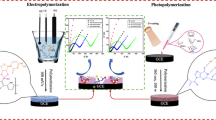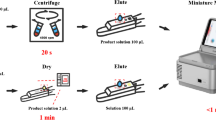Abstract
A novel pretreatment method, which was performed using a two-dimensional high-performance liquid chromatography (2D-HPLC) system, was proposed for the direct analysis of drugs in human serum. A temperature-responsive column was used as a pretreatment column. The stationary phase of the temperature-responsive column exhibits temperature-regulated hydrophilic/hydrophobic characteristics. Controlling the ionic strength of the eluent enables human serum albumin (HSA) to pass through the column without retention. When serum samples containing barbiturates or benzodiazepines were injected into the temperature-responsive column using 10 mM of ammonium acetate (pH 6.5) as the mobile phase and in the temperature range of 10–40 °C, HSA was eluted from the column near the dead time, followed by the individual drugs. When the column temperature was changed, the retention times of the drugs were altered owing to surface property changes within the pretreatment column. These closely eluted compounds were subsequently introduced into the analytical column using a column-switching valve, with a minimal gap time to avoid foreign substance contamination. This new 2D-HPLC method afforded high-quality chromatograms of multiple drugs without unwanted peaks from foreign substances. The present technique could be an attractive choice in selecting the analytical method for drug analysis.





Similar content being viewed by others
References
Souverain S, Rudaz S, Veuthey JL. Restricted access materials and large particle supports for on-line sample preparation: an attractive approach for biological fluids analysis. J Chromatogr B. 2004;801:141–56.
Mullett WM, Pawliszyn J. Direct LC analysis of five benzodiazepines in human urine and plasma using an ADS restricted access extraction column. J Pharm Biomed Anal. 2001;26:899–908.
Walles M, Borlak J, Levsen K. Application of restricted access material (RAM) with precolumn-switching and matrix solid-phase dispersion (MSPD) to the study of the metabolism and pharmacokinetics of Verapamil. Anal Bioanal Chem. 2002;374:1179–86.
Brunetto R, Gutierrez L, Delgado Y, Gallignani M, Burguera JL, Burguera M. High-performance liquid chromatographic determination of cocaine and benzoylecgonine by direct injection of human blood plasma sample into an alkyl-diol-silica (ADS) precolumn. Anal Bioanal Chem. 2003;375:534–8.
Papp R, Mullett WM, Kwong E. A method for the direct analysis of drug compounds in plasma using a single restricted access material (RAM) column. J Pharm Biomed Anal. 2004;36:457–64.
Rao RN, Vali RM, Shinde DD. On-line 2D-LC-ESI/MS/MS determination of rifaximin in rat serum. Biomed Chromatogr. 2009;23:1145–50.
Ding J, Neue UD. A new approach to the effective preparation of plasma samples for rapid drug quantitation using on-line solid phase extraction mass spectrometry. Rapid Commun Mass Spectrom. 1999;13:2151–9.
Zimmer D, Pickard V, Czembor W, Muller C. Turbulent flow chromatography combined with tandem mass spectrometry for directly injecting raw plasma samples derived from pharmacokinetic studies. Chromatographia. 2000;52:S26–7.
Kollroser M, Schober C. Direct-injection high performance liquid chromatography ion trap mass spectrometry for the quantitative determination of olanzapine, clozapine and N-desmethylclozapine in human plasma. Rapid Commun Mass Spectrom. 2002;16:1266–72.
Herman JL. Generic method for on-line extraction of drug substances in the presence of biological matrices using turbulent flow chromatography. Rapid Commun Mass Spectrom. 2002;16:421–6.
Kollroser M, Schober C. An on-line solid phase extraction–liquid chromatography–tandem mass spectrometry method for the analysis of citalopram, fluvoxamine, and paroxetine in human plasma. Chromatographia. 2003;57:133–8.
Okuda T, Nakagawa Y, Motohashi M. Complete two-dimensional separation for analysis of acidic compounds in plasma using column-switching reversed-phase liquid chromatography. J Chromatogr B. 1999;726:225–36.
Gray MJ, Dennis GR, Slonecker PJ, Shalliker RA. Separation of oligostyrene isomers in a complex mixture using two-dimensional heart-cutting reversed-phased liquid chromatography. J Chromatogr A. 2004;1028:247–57.
Wong V, Shalliker RA. Isolation of the active constituents in natural materials by ‘heart-cutting’ isocratic reversed-phase two-dimensional liquid chromatography. J Chromatogr A. 2004;1036:15–24.
Moretton C, Cretier G, Nigay H, Rocca JL. Heart-cutting two-dimensional liquid chromatography methods for quantification of 2-acetyl-4-(1,2,3,4-tetrahydroxybutyl)imidazole in Class III caramel colours. J Chromatogr A. 2008;1198-1199:73–9.
Apffel JA, Alfredson TV, Majors RE. Automated on-line multi-dimensional high-performance liquid chromatographic techniques for the clean-up and analysis of water-soluble samples. J Chromatogr A. 1981;206:43–57.
Kanazawa H, Yamamoto K, Matsushima Y, Takai N, Kikuchi A, Sakurai Y, et al. Temperature-responsive chromatography using poly (N-isopropylacrylamide)-modified silica. Anal Chem. 1996;68:100–5.
Kanazawa H, Sunamoto T, Matsushima Y, Kikuchi A, Okano T. Temperature-responsive chromatographic separation of amino acid phenylthiohydantoins using aqueous media as the mobile phase. Anal Chem. 2000;72:5961–6.
Kanazawa H, Sunamoto T, Ayano E, Matsushima Y, Kikuchi A, Okano T. Temperature-responsive chromatography using poly-(N-isopropylacrylamide) hydrogel-modified silica. Anal Sci. 2002;18:45–8.
Ayano E, Okada Y, Sakamoto C, Kanazawa H, Kikuchi A, Okano T. Study of temperature-responsibility on the surfaces of a thermo-responsive polymer modified stationary phase. J Chromatogr A. 2006;1119:51–7.
Ayano E, Kanazawa H. Aqueous chromatography system using temperature-responsive polymer-modified stationary phases. J Sep Sci. 2006;29:738–49.
Kanazawa H, Okano T. Temperature-responsive chromatography for the separation of biomolecules. J Chromatogr A. 2011;1218:8738–47.
Hiruta Y, Kanazashi R, Ayano E, Okano T, Kanazawa H. Temperature-responsive molecular recognition chromatography using phenylalanine and tryptophan derived polymer modified silica beads. Analyst. 2016;141:910–7.
Satti AJ, Espeel P, Martens S, Hoeylandt TV, Prez FED, Lynen F. Tunable temperature responsive liquid chromatography through thiolactone-based immobilization of poly(N-isopropylacrylamide). J Chromatogr A. 2015;1426:126–32.
Liang Y, Geng F, Dai R, Deng Y. Enrichment of adenosine using thermally responsive chromatographic materials under friendly pH conditions. J Sep Sci. 2015;38:4036–42.
Kudo K, Ishida T, Hikiji W, Usumoto Y, Umehara T, Nagamatsu K, et al. Pattern of poisoning in Japan: selection of drugs and poisons for systematic toxicological analysis. Forensic Toxicol. 2010;28:25–32.
Akimaru M, Okubo K, Hiruta Y, Kanazawa H. Temperature-responsive solid-phase extraction column for biological sample pretreatment. Anal Sci. 2015;31:881–6.
Yakushiji T, Sakai K, Kikuchi A, Aoyagi T, Sakurai Y, Okano T. Effects of cross-linked structure on temperature-responsive hydrophobic interaction of poly(N-isopropylacrylamide) hydrogel-modified surfaces with steroids. Anal Chem. 1999;71:1125–30.
Acknowledgments
The authors appreciate Hitachi High-Technologies Corporation for providing valuable information. This study was supported in part by a Grant-in-Aid for Scientific Research (B) (Grant No. 21390012 and 25293009) from the Ministry of Education, Culture, Sports, Science and Technology, Japan.
Author information
Authors and Affiliations
Corresponding author
Ethics declarations
Conflict of interest
The authors declare that they have no conflicts of interest.
Electronic supplementary material
Below is the link to the electronic supplementary material.
ESM 1
(PDF 218 kb)
Rights and permissions
About this article
Cite this article
Mikuma, T., Uchida, R., Kajiya, M. et al. The use of a temperature-responsive column for the direct analysis of drugs in serum by two-dimensional heart-cutting liquid chromatography. Anal Bioanal Chem 409, 1059–1065 (2017). https://doi.org/10.1007/s00216-016-0024-9
Received:
Revised:
Accepted:
Published:
Issue Date:
DOI: https://doi.org/10.1007/s00216-016-0024-9




